Return to Space
NASA is readying the space shuttle Discovery for its first launch in more than 2 years.
By Emily Sohn
I was a fifth-grader when the space shuttle Challenger blew up on Jan. 28, 1986. I’ll never forget that day.
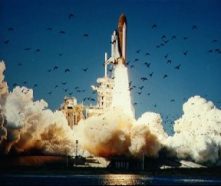 |
|
Not long after the space shuttle Challenger lifted off on Jan. 28, 1986, it exploded.
|
| NASA |
For weeks before the launch, people had been talking about the mission. It was the first time a civilian would travel to outer space. Her name was Christa McAuliffe, and she was a 37-year-old teacher. She was married. And she had two young children. If an ordinary person like her could go into space, we thought, anybody could.
When the shuttle exploded just 73 seconds after take-off, McAuliffe died along with six other astronauts. It was 20 minutes before noon on a Tuesday. The news spread quickly.
At my school, an announcement came over the loudspeakers while I was in the middle of math class. We all put our heads down, and the entire school remained silent for a full minute. That minute seemed like a really long time.
Plenty of people, including civilians, have traveled safely to outer space since then, but I’ve been afraid of space travel. When the shuttle Columbia exploded 2 years ago, killing all seven astronauts on board, I decided that I would never go into space, even if I had the chance.
“The reality is that space exploration is inherently dangerous and inherently risky,” says Allard Beutel of the National Aeronautics and Space Administration (NASA).
Some people argue that human lives are not worth risking for the sake of space exploration. NASA, however, has not given up on sending people back out there.
“The risks are worth taking as long as you take them responsibly,” Beutel says. You also have to know what you’re doing. “Movies make space travel seem routine,” he says. “It’s anything but that.”
First launch
Sometime in May, the first shuttle launch since the Columbia disaster in 2003 is scheduled to carry seven astronauts into space.
One goal of the mission, called STS-114 or “Return to Flight,” is to continue building the International Space Station. Sixteen nations are working together to build the station, which will serve as an orbiting base for further research and exploration.
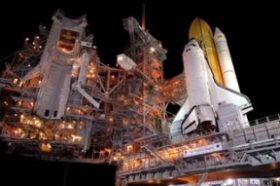 |
|
The space shuttle Discovery arrives at the launch pad in April in preparation for a launch that may occur in May.
|
| NASA |
The space shuttle Discovery, followed several months later by Atlantis, will also test new safety procedures and cutting-edge techniques for shuttle repair.
With a team of more than 10,000 people, NASA has taken every kind of precaution possible to avoid another Columbia or Challenger-type disaster. “We’ve spent the better part of 2 years making upgrades and improvements to make sure that doesn’t happen again,” Beutel says.
Columbia’s downfall began 83 seconds after launch, when a chunk of foam insulation broke off its external fuel tank and hit the left wing, damaging it.
When a spacecraft speeds back down to Earth, the body of the craft can heat up to as much as 3,000 degrees, Beutel says. During Columbia’s reentry after 16 days in orbit, superheated air broke apart the weakened wing, and the whole shuttle shattered.
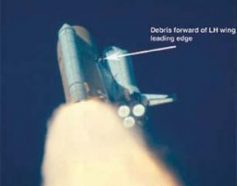 |
|
Soon after launch, a piece of foam insulation broke off and struck the wing of space shuttle Columbia.
|
| NASA |
To protect Discovery from the same fate, scientists removed all foam from the shuttle’s fuel tank. The foam was there to keep ice from forming on the tank. Now, electric heaters will do the job instead.
NASA has also come up with better ways of detecting any damage that might occur during launch. Impact sensors in the wings will alert ground control if ice or bits of debris slam into the shuttle on its way up. Because the shuttle travels at such high speeds (as high as 17,500 miles per hour), even minor impacts can cause major damage.
At the same time, lots of new, high-definition cameras will take pictures and use radar to record every second of the launch from more angles than ever. These images should show any impacts that the impact sensors miss.
And there’s more. Once the shuttle reaches the space station, it will get a major checkup by lasers and cameras on the space shuttle’s 50-foot-long robotic arm.
“The space shuttle will do a full turn, kind of like a somersault,” Beutel says, “to allow the space station crew to take digital pictures of it and look at possible damage. They’ll immediately transmit these images to controllers on the ground, who will look at them in great detail.”
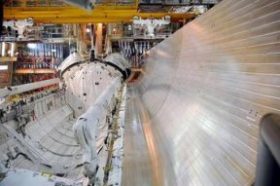 |
|
At NASA’s Kennedy Space Center, technicians installed the new Orbiter Boom Sensor System (center) and the Remote Manipulator System (left) in the space shuttle Discovery. The boom sensor system is one of the shuttle’s new safety measures, equipping the orbiter with cameras and laser systems to inspect the shuttle’s surface while in space. |
| NASA |
If something does go wrong on the way up, the astronauts will use the space station as a platform for taking spacewalks and making repairs. If they can’t fix what’s wrong, the astronauts will take refuge in the space station, and Atlantis will take an emergency trip to pick them up.
With such careful preparations, this last scenario should be extremely unlikely, Beutel says. “I can’t stress enough that that’s a backup plan to a backup plan to a backup plan.”
Building a space station
Getting shuttles back into space is a major priority for NASA. That’s because the current space shuttles are the only vehicles available that can carry up large structures, dock at the International Space Station, and finish building the station.
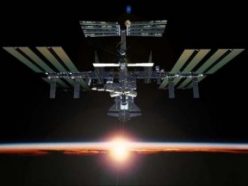 |
|
An artist’s impression of what the International Space Station would look like when completed.
|
| ISS/NASA |
It should take 28 more shuttle flights to finish the project, Beutel says. Once it’s done, the station could serve as a way station for trips into the distant solar system and beyond.
“We’re not just trying to go to Mars or the moon,” Beutel says. “We’re trying to put people out in space permanently.”
Eventually, NASA plans to launch a whole new, updated fleet of spacecraft. It’s not clear yet exactly what the new vehicles will look like, but they’re sure to be safer and better than what’s available now. Today’s shuttles were built in the 1970s and 80s. Technology has come a long way since then.
The first unmanned test flights of the new craft should go up in 2008, Beutel says. By 2014, NASA plans to use them to send people to the moon.
By then, you might be in the perfect position to get on board. “It’s very possible that the elementary and middle school students reading this right now are the ones who are going to be going up on missions to Mars and the moon,” he says. “The work we’re doing today paves the way for them.”
Christa McAuliffe expressed the same sentiment. “One of the things I hope to bring back into the classroom,” she said before launch in 1986, “is to make that connection with the students that they too are part of history, the space program belongs to them, and to try to bring them up with the space age.”
Today’s astronauts are willing to take risks, because they believe they’re doing something important. Someday, you too could push the limits of human exploration into outer space. When you get there, send me a postcard. I’m happy to stay right here on Earth.
UPDATE: The launch of the space shuttle Discovery was delayed until at least the middle of July mainly because of concerns that chunks of ice could break away from the spacecraft’s external fuel tank and cause damage. Discovery went back to the Vehicle Assembly Building to have the problem fixed.
Going Deeper:







